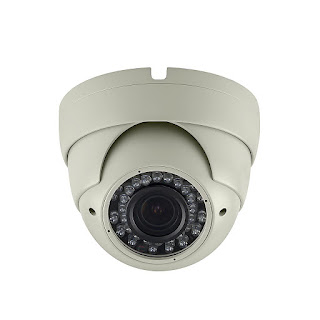Very often we are asked “What camera should we choose?” “What is the difference between Dome & Bullet Cameras?” etc. In this article we will describe every type of camera briefly.
CCTV cameras come in various types, styles, and configurations, and it is very important to choose the right CCTV camera for the right location and application.
Dome Cameras
In general, Dome Cameras are used for indoor security and surveillance applications. The cameras are named so, because of their dome like shape. The "dome" shape makes it difficult to tell the direction that these cameras are facing, and thus are ideal for deterring criminals.
Dome cameras can be fitted or embedded to ceilings to conceal the majority of camera’s casing.
Bullet Cameras
Bullet cameras are easy to recognize by their thin and cylindrical design. There are also classifications of Ultra Bullet distinguished by their smaller size and cheaper price. These type of
cameras are ideal for surveillance of a large area, like large retail stores, houses or other business.
Unlike dome cameras,
bullet cameras are easy to tell, where the camera is pointing and what it is recording.
Day/Night Security Cameras
Day&Night security cameras usually operate in two modes: colour for daytime, when light levels are high and black and white for viewing in low-light environment. A true Day/Night camera will have an “IR-cut filter” inside the camera. Once the IR cut filter is removed from the surveillance camera, it enables the image sensor to become sensitive to near-IR wavelengths, thus making it possible for the camera’s light sensitivity to reach down to extremely low light levels or even complete darkness.
Vandal-Proof Security Cameras

Vandal proof security cameras are equipped with a metal housing that prevents the camera from damage from vandalism, physical abuse or possible maltreatment. All homes or businesses should strongly consider vandal proof security cameras for their video surveillance system installation.
Vandal proof security cameras are often utilized in high-security areas like warehouses, banks, airports, hotels, parking lots, and retail stores.
You can also typically find vandal-proof cases that are designed to protect more sensitive cameras, giving you the protection that you need without having to go out and purchase a brand new camera
IP/Network Security Camera
An Internet protocol camera, or IP camera, is a type of digital video camera commonly employed for surveillance, and which, unlike analog CCTV cameras, can send and receive data via a computer network and the Internet.
IP cameras, both hardwired and wireless, are easier to install than analog cameras because they do not require a separate cable run or power boost to send images over a longer distance.
C-Mount CCTV Camera
C-mount CCTV cameras have detachable lenses to fit different applications. Standard CCTV camera lenses can only cover distances of between 35 and 40ft, therefore with C-mount CCTV cameras, it is possible to use special lenses, which can cover distances greater than 40ft.
 PTZ Security Cameras
PTZ Security Cameras
PTZ Security Cameras allow you to control the pan, tilt and zoom operations of the camera lens remotely. PTZ Cameras have the ability to move up, down, right, left, and even zoom.
Image result for
HDTVI cameras HDTVI (High Definition Transport Video Interface) is latest HD analog video solution. HDTVI can provide HD video up to 1080P resolution at real time. Different from HD-CVI and HD-SDI solutions, HDTVI can support long distance video transmission.
HD-SDI CCTV cameras, also known as HD security cameras, are capable of capturing video surveillance footage at 1080p resolution (1920 x 1080 pixels). These high definition surveillance cameras must be used with an HD-SDI surveillance DVR.
A hidden camera or spy camera or security camera is a still or video camera used to record people without their knowledge. The camera is "hidden" because it is either not visible to the subject being filmed, or is disguised as another object.


















